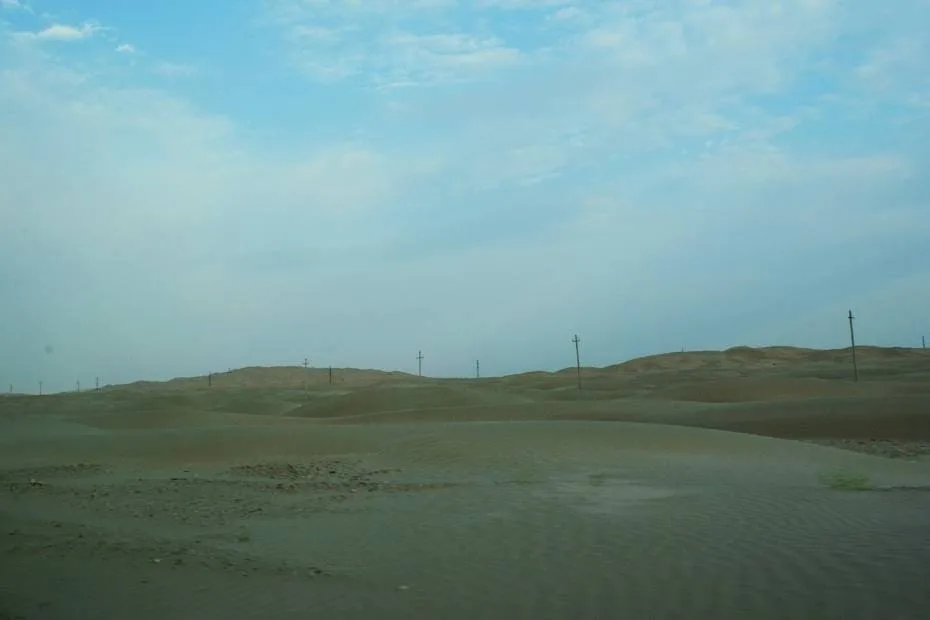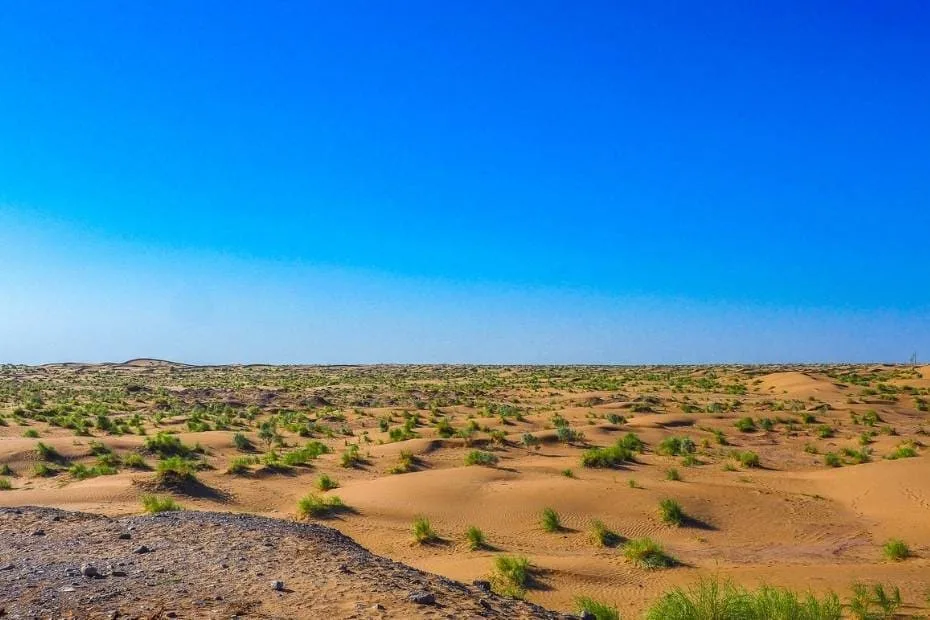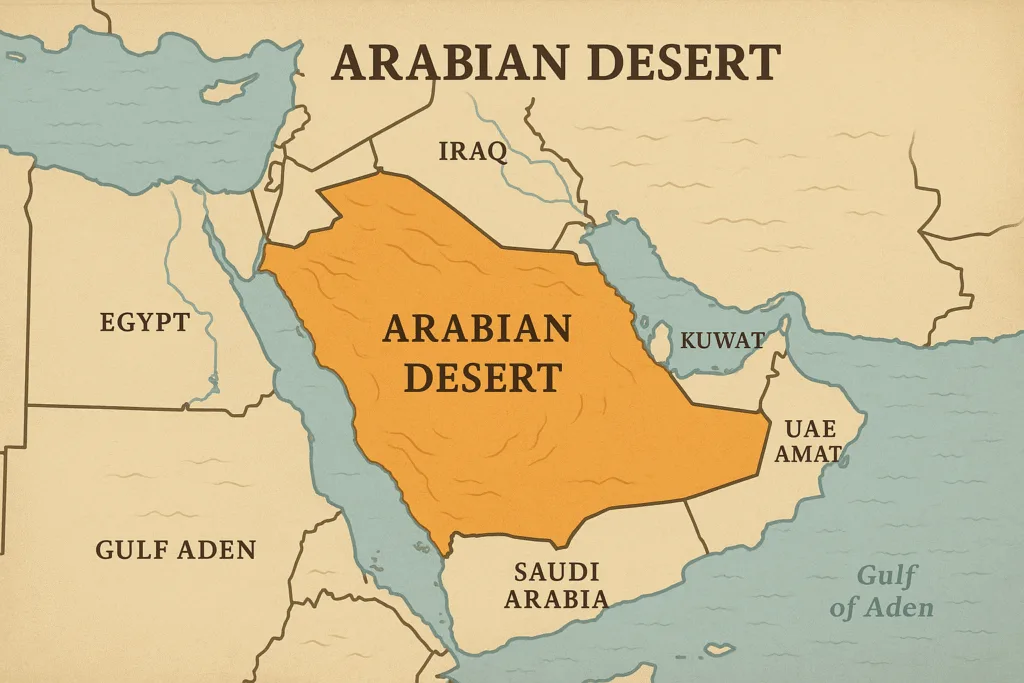Location & Continent
Continent: Asia
Countries: Turkmenistan (mainly), with smaller portions extending into Uzbekistan and Kazakhstan
Coordinates: 39°N, 59°E
Kara Kum Desert – Map & Street View
Photos of the Kara Kum Desert
Physical Features
Area: Approximately 350,000 km² (covering nearly 80% of Turkmenistan)
Length: Around 800 km
Width: Roughly 500 km
Elevation: Typically between 60 and 200 m above sea level, gradually rising toward the Kopet Dag foothills in the south
Climate & Precipitation
Temperature: Summer highs reach 45–50 °C; winter temperatures can fall below −15 °C in northern regions
Precipitation: 70–150 mm annually on average, with most rainfall occurring in spring and early winter; evaporation greatly exceeds precipitation
Ecological Features
Ecozone: Palearctic (cold desert and semi-arid steppe)
Biome: Temperate desert and xeric shrubland
Ecoregions: Karakum Desert (Turanian Desert System), Amu Darya Delta semi-desert, southern Turan saline basins
Flora & Fauna
Flora: Dominated by saxaul (Haloxylon persicum), saltworts (Salsola), wormwood (Artemisia), Calligonum and tamarisk shrubs, with ephemeral spring grasses after rare rains
Fauna: Goitered gazelles, sand cats, caracals, corsac foxes, desert monitors (Varanus griseus), Central Asian tortoises (Testudo horsfieldii), jerboas, houbara bustards, and desert warblers
Geology & Notable Features
Geology: Formed from ancient alluvial and aeolian sediments deposited by the Amu Darya basin; includes sand seas, takyr clay pans, and salt flats like the Kara Bogaz Gol depression
Notable Features: Darvaza Gas Crater (“Door to Hell”), Repetek Nature Reserve (UNESCO Biosphere Reserve), Karakum Canal (one of the world’s longest irrigation canals), the Uzboy dry riverbed, and the Karashor Depression
Introduction to Kara Kum Desert
The Kara Kum, also known as the Karakum Desert, is a prominent and expansive desert located in Central Asia, primarily within the borders of Turkmenistan. Spanning approximately 350,000 square kilometers, it represents one of the largest deserts in the region. This article delves into the unique characteristics, ecological aspects, and comparative significance of the Kara Kum Desert.
Geographical Features of Kara Kum
The geography of the Kara Kum Desert is marked by its vast stretches of sandy dunes, intricate clay areas, and salt flats. It can be divided into two main areas: the northern part consists primarily of hard clay plains, while the southern expanse showcases impressive sand dunes reaching heights of up to 250 meters. The geographical layout facilitates the existence of several oases, pivotal for local wildlife and human settlements.
Climate Conditions
The climate in the Kara Kum Desert is classified as arid continental, characterized by extreme temperature variations. In summer, daytime temperatures can exceed 50°C (122°F), while winter nights can drop below -20°C (-4°F). Precipitation is scarce, averaging about 100-150 mm annually, making water a precious commodity in this arid environment.
Flora and Fauna
The biodiversity of the Kara Kum Desert, while limited due to the harsh climate, includes a range of adapted plant species and resilient wildlife. Notable flora includes various types of halophytes, which thrive in saline conditions. The fauna consists of animals such as desert foxes, lizards, and the elusive Persian gazelle. The survival strategies of these species illustrate remarkable adaptations to desert life.
Ecosystem and Conservation
Despite its harsh conditions, the Kara Kum Desert supports unique ecosystems. However, the desert faces threats from climate change, human activities, and desertification. Conservation efforts are critical for maintaining the delicate balance of this ecosystem. Initiatives focus on protecting unique habitats, managing water resources, and promoting sustainable land use practices.
Economic Importance of the Kara Kum Desert
Economically, the Kara Kum Desert holds significance for gas and oil production. The region is rich in fossil fuels, which contribute to Turkmenistan’s economy. Additionally, petrochemical industries are vital to the local economy, providing employment and revenue.
Comparison with Other Deserts
To truly understand the Kara Kum, it is beneficial to compare it with other notable deserts. Below is a detailed table showcasing key comparisons between the Kara Kum and other significant deserts like the Sahara and the Gobi.
| Desert | Area (sq km) | Climate Type | Average Temperature (°C) | Annual Precipitation (mm) |
|---|---|---|---|---|
| Kara Kum | 350,000 | Arid Continental | 5 – 50 | 100 – 150 |
| Sahara | 9,200,000 | Hot Desert | 15 – 45 | 100 – 250 |
| Gobi | 1,295,000 | Cold Desert | -40 – 40 | 100 – 200 |
Conclusion
The Kara Kum Desert, with its unique geographical features, climate conditions, and ecological significance, is a vital part of Central Asia’s landscape. Understanding its characteristics and comparing it with other deserts enhances our appreciation for this remarkable ecosystem. Protective measures and sustainable practices are essential to preserve the Kara Kum for future generations.
References
Government / Official Sources
Government of Turkmenistan — “Repetek Biosphere State Reserve: A Living Laboratory in the Kara Kum Desert”
U.S. Geological Survey — “Desertification and Sand Dynamics in the Kara Kum Desert, Turkmenistan”
UNESCO — “Repetek Biosphere Reserve (Kara Kum Desert, Turkmenistan)”
University Sources
Moscow State University — “Climate and Vegetation of the Kara Kum Desert”
Cambridge University Press — “Kara Kum Desert: Sand Dynamics and Environmental Change”




